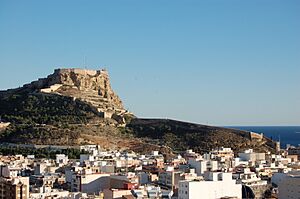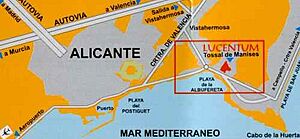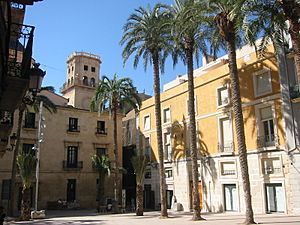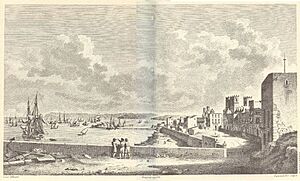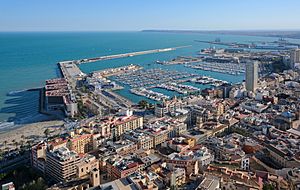History of Alicante facts for kids
The history of Alicante goes back thousands of years. This city in Spain has always been an important place on the Mediterranean coast. It was a great spot for military defense. Santa Bárbara Castle (Valencian: Castell de Santa Bàrbara) stands high above the city. Parts of this castle were built in the 800s. It sits on top of Mount Benacantil, a rocky hill overlooking the sea.
The first people to live in the Alicante area were Iberian tribes. After them, many other groups lived there. These included the Phoenicians, Greeks, Romans, Goths, Moors, and finally, the Spanish. Some of the very first homes were built on Mount Benacantil. This is the same hill where Santa Bárbara Castle is today. Later, the Romans called the area "Lucentum." It was part of the Roman province of Hispania.
Contents
Ancient Times in Alicante
Early Trading Settlements
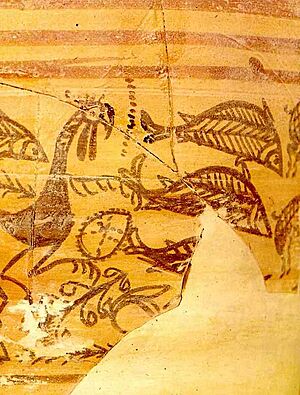
Around 800 BC, Phoenician traders started trading with the local Iberian people. They set up trading posts along the coast of eastern Spain. By 700 BC, the Phoenicians brought new ideas to the Iberians. They introduced their alphabet, iron tools, and the pottery wheel.
Later, in the 600s BC, Greek traders also built small ports. One important Phoenician city was La Fonteta, south of Alicante. It was in a good spot to control trade and access to valuable minerals. This city had strong defensive walls with towers.
Carthaginian Influence
By the late 500s BC, the armies of Carthage and Rome began to fight for control of Spain. The Carthaginian general Hamilcar Barca conquered parts of Iberia around 237–228 BC. He built a strong settlement called Ákra Leukḗ (meaning "White Citadel") where Alicante is now.
Archaeologists have found items from different cultures in this area. This shows that people from various backgrounds lived and traded together. The settlements had good harbors. This helped them move goods by sea.
Experts still discuss how much these foreign groups changed local societies. Some believe they brought big social and economic changes. Others think their presence alone did not cause such changes.
The settlement at Tossal de les Basses was near a lagoon. It had a strong wall with towers built around 500 BC. This shows the coast was becoming very important. Outside the walls, there was an area for making things. People worked with metal and made pottery. They also made goods like amphorae (large jars) for export.
People in the area grew many crops. These included olives, grapes, pomegranates, apples, pears, and figs. These fruits were likely exported too. The coastal towns focused on processing and trading these products.
An Iberian village existed on Tossal de les Basses around 400 BC. It was abandoned when the Carthaginians took over. The Carthaginians built a large fort at Tossal de Manises around 230 BC. This fort later grew into a city. The Iberian name for this place might have been LAKKANTÓ. This name probably described the land's features.
This Carthaginian fort was first used for military defense. Later, it became a fortified city. The Iberians likely moved to this new Punic settlement. The Carthaginians called it Leuce. This name was probably a Greek version of an older Iberian name.
Roman Rule and Decline
The city was destroyed in 209 BC during the Second Punic War. It was left empty for a long time. But it was rebuilt during the Sertorian War (80 to 72 BC). Under the Roman emperor Augustus, it became a Roman town called Lucentum. This name is found in old writings from that time. Historians now agree that Lucentum was located at Tossal de Manises.
The city grew and developed. Its first public meeting place, called a forum, was built around 30 to 20 BC. This showed Lucentum's new status as a Roman town. The rest of the city was planned and built over the next few decades.
Lucentum was quite grand from the late 1st century BC to the 1st century AD. But it started to decline later. By the 2nd century, the city was slowly falling apart. By the 3rd century, it was completely abandoned. Its land became part of the nearby Roman town of Ilici (modern-day Elche). Ilici was more successful because it had better water and roads.
A new settlement grew on the slopes of Mount Benacantil. It used a Romanized name, Lacant. This name later became the Arabic Laqant. This is the origin of the modern name Alicante.
Muslim al-Laqant
The Kingdom of Tudmīr
The Roman settlement eventually became empty. Then, a new town grew between the 500s and 600s. During the early Muslim rule, the Tossal de Manises site was used as a Muslim cemetery. It seems the Muslim city of Laqant developed on the other side of the Serra Grossa hill. This is where the historic center of Alicante is today.
Between 718 and 1247, the Arabs ruled the town. They called it Madīnah Laqant or Medina Laqant, meaning "the city of Laqant." This name is the direct origin of the modern name Alacant in Valencian and Alicante in Spanish. It was also known as Laqant-al-Qubra, or "Great Alicante."
Alicante was one of seven cities in the kingdom of Tudmīr. This kingdom was formed by a peace agreement called the Pact of Theodemir in 713. The people of Alicante lived in the hills. They farmed crops like cereals, olives, and grapes. They also gathered wild animals, honey, and esparto grass. The town had a market and built ships.
The Muslim rulers respected the local people's freedom. The local leaders, who were of Germanic origin, tried to keep their power. They often married into Muslim families to protect their status. The new Muslim rulers also married local aristocrats to secure their land and power.
New settlers arrived, helping old Roman towns grow again. Many local people converted to Islam. They continued to live in the higher areas near Alicante. The local leaders lost their special rights when the Pact of Theodemir was ended.
Caliphate of Qúrtuba
The former kingdom of Tudmīr became a province of the Umayyad emirate of Córdoba. After other ports were destroyed, Alicante's port became very important in the 800s. It was the only usable harbor between the Ebro Delta and Almería. This led to a stable town at the foot of Benacantil. Sailors lived there, fishing and trading.
Under Emir Muhammad I, the city became strategically important. This was thanks to its strong castle and the busy Via Augusta road nearby. The region was divided into two main areas. Alicante was in the southern area, part of Murcia.
The leaders of Laqant joined a rebellion between 880 and 918. They wanted to protect their status. Many local people also supported the revolt because of high taxes. After the revolt was put down, Abd al-Rahman III created the Caliphate of Córdoba.
The government then changed its tax system. This made state income grow a lot. They also reorganized the countryside. They replaced mountain defenses with a network of forts and watchtowers. People in rural areas moved into fortified villages linked to castles. Alicante and Kalyusha became central for administration and defense.
Xarq al-Andalus Era
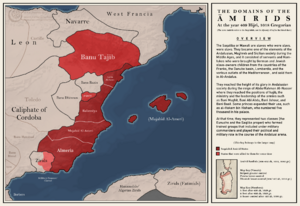
The Caliphate of Córdoba's power did not last long. In 1014, a powerful Slavic warlord named Mujāhid al-ʿĀmirī took control. He created the Taifa of Dénia and conquered the Balearic Islands.
Controlling the Balearics gave Mujāhid a supply center for trade. It also provided a defensive outpost and a base for sea attacks. Under his rule, the Taifa of Dénia became very rich and powerful. In 1021, Mujāhid added Elx, Orihuela, and Laqant to his lands.
During the rule of the Banū Mujāhid, Alicante had free trade. This was key to Dénia's control of trade in the western Mediterranean. People's lives improved, and there were advances in culture and science. There was also peace with neighboring areas.
According to the writer Muhammad al-Idrisi, Laqant was a rich town in the 11th century. It had a market and two mosques. The land was fertile, producing many fruits and vegetables. They exported Soda ash for glass-making and ropes made of spartum through the port. Fishing and trade ships were also built there.
Its castle, called an alcazaba, was on the hard-to-reach peak of Benacantil. It had many soldiers. Alicante became an important port for trade with North Africa. It also connected to the Via Augusta road, linking it to Valencia, Murcia, and Andalucia. This made it a major trading and sea center. It was also a port for shipping extra farm products from the area.
Christian Rule: Castile and Aragon
Muslims ruled southern and eastern Spain until the reconquista (reconquest). This was when Christian forces took back the land. Alicante was captured in 1246 by the Castilian king Alfonso X. But it soon became part of the Kingdom of Valencia in 1298. This happened under the Catalan King James II of Aragon. Alicante then became a Royal Villa, with a say in the Valencian Parliament.
Early Modern Era
After many years of fighting between the Kingdom of Castile and the Crown of Aragon, Alicante had a "golden age" in the 1400s. This was true for the whole Kingdom of Valencia. Alicante became a major Mediterranean trading center. It exported rice, wine, olive oil, oranges, and wool.
Between 1609 and 1614, King Philip III forced thousands of moriscos to leave Valencia. These were Muslims who had stayed after the reconquest. They were seen as loyal to Berber pirates who attacked coastal cities. This act hurt the region badly. Many skilled workers and farmers left, causing problems for the local nobles.
In the early 1700s, Alicante supported Carlos in the War of Spanish Succession. Philip V won the war. He punished Valencia by taking away its special self-governing status. This status had been in place since the reconquest.
19th and 20th Centuries
Alicante slowly declined through the 1700s and 1800s. But the city's leather industry, farming (like oranges and almonds), and fishing helped it survive. The late 1800s saw a strong recovery. International trade grew, and the city's harbor became busier. Exports increased, especially during World War I when Spain was neutral.
In the early 1900s, Alicante was a smaller capital. Spain's neutrality in the First World War brought new chances for industry and farming. In the 1920s, many men from Alicante were sent to fight in the Moroccan war. Political unrest led to republican leaders winning local elections. King Alfonso XIII then left the throne.
The Second Spanish Republic was announced on April 14, 1931. This was celebrated in Alicante. The Spanish Civil War started on July 17, 1936. Alicante was the last city loyal to the Republic. General Franco's troops took it on April 1, 1939. The last Republican government officials fled the country from Alicante's harbor.
Alicante was bombed many times during the civil war. The most famous bombing was by Italian planes on May 25, 1938. This attack on the Central Market killed over 300 civilians.
The next 20 years under Franco's rule were hard for Alicante. But in the late 1950s and early 1960s, the city changed a lot because of tourism. Large buildings and resorts were built in nearby areas. Alicante's good climate attracted many visitors and buyers.
The growth of tourism also brought new businesses. Many restaurants, bars, and shops opened for visitors. The old airfield at Rabasa closed. Air traffic moved to the new El Altet Airport. This made it easy for charter flights to bring tourists from northern European countries.
When Francisco Franco died in 1975, Juan Carlos I became king. He successfully led Spain to become a democratic country. Regions like Valencia were given more self-rule. Valencia gained autonomy it had not had for four centuries.
Later, important developments included the opening of the European Union Office for Harmonization in the Internal Market. Also, the Ciudad de la Luz was built. These facilities were made to help film industries set up in Alicante.
See also
- Timeline of Alicante


